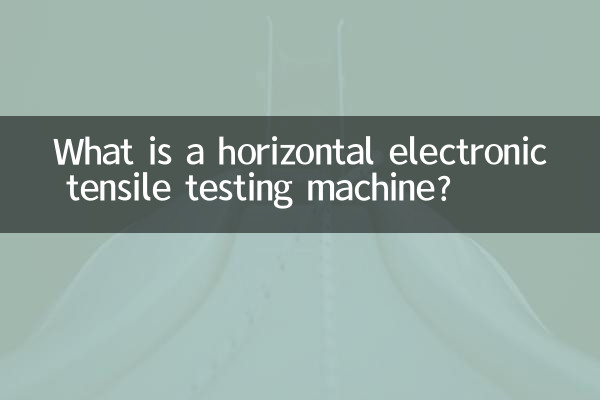What is a horizontal electronic tensile testing machine?
In the fields of industrial manufacturing, material science and quality inspection, the horizontal electronic tensile testing machine is an important testing equipment. It is mainly used to test the tensile, compression, bending and other mechanical properties of materials, and is widely used in the quality control and research and development of metals, plastics, rubber, textiles and other materials. This article will introduce in detail the definition, working principle, application fields and comparison of popular models in the market of horizontal electronic tensile testing machines.
1. Definition of horizontal electronic tensile testing machine

The horizontal electronic tensile testing machine is a mechanical testing equipment designed with a horizontal structure. It achieves accurate measurement of the mechanical properties of materials through an electronic control system. Compared with the vertical tensile testing machine, the horizontal design is more suitable for testing long or large-volume samples, and has the characteristics of high stability and easy operation.
2. Working principle
The horizontal electronic tensile testing machine uses a motor to drive a ball screw or a hydraulic system to apply tension or pressure to the sample. The force sensor and displacement sensor collect data in real time and transmit it to the control system for processing and analysis. Users can set test parameters, view curves and generate reports through the supporting software.
3. Main technical parameters
| Parameter name | Description |
|---|---|
| Maximum test force | Usually ranging from 1kN to 1000kN |
| Measurement accuracy | Generally ±0.5%-±1% |
| Stretch stroke | 500mm-2000mm ranging |
| Test speed | 0.001-500mm/min adjustable |
| control system | PLC or industrial computer |
4. Application fields
Horizontal electronic tensile testing machines are widely used in various industries:
| Industry | Application scenarios |
|---|---|
| metal material | Tensile property testing of metal rods and pipes |
| plastic rubber | Mechanical property testing of plastic films and rubber products |
| building materials | Tensile strength testing of steel bars and concrete components |
| automobile manufacturing | Durability testing of automotive parts |
| Aerospace | Research on mechanical properties of aviation materials |
5. Comparison of popular models in the market
According to market hot data in the past 10 days, the following is a parameter comparison of three popular horizontal electronic tensile testing machines:
| Model | Maximum test force | Accuracy | Features | price range |
|---|---|---|---|---|
| WDL-100 | 100kN | ±0.5% | PLC control, touch screen operation | 80,000-120,000 yuan |
| WHY-300 | 300kN | ±1% | Hydraulic drive, large stroke | 150,000-200,000 yuan |
| WES-500 | 500kN | ±0.5% | Computer controlled, multi-function test | 250,000-350,000 yuan |
6. Purchase suggestions
1. Select the appropriate range and accuracy according to the test requirements
2. Consider the scalability of the equipment, such as whether it is necessary to add accessories such as environmental boxes
3. Give priority to brands with perfect after-sales service
4. Pay attention to the metrology certification and standard compliance of the equipment
7. Latest technology development trends
1. Intelligent: More and more devices use AI algorithms for data analysis
2. Networking: supports remote monitoring and data cloud storage
3. Multifunctional: One piece of equipment can complete various tests such as tension, compression, and bending.
4. Green and energy-saving: new drive system reduces energy consumption
As an important tool for material testing, the technological development of horizontal electronic tensile testing machines reflects the increasing emphasis on quality control in the manufacturing industry. As new materials continue to emerge, the requirements for testing equipment are also increasing. In the future, horizontal electronic tensile testing machines will develop in a smarter and more accurate direction.

check the details

check the details